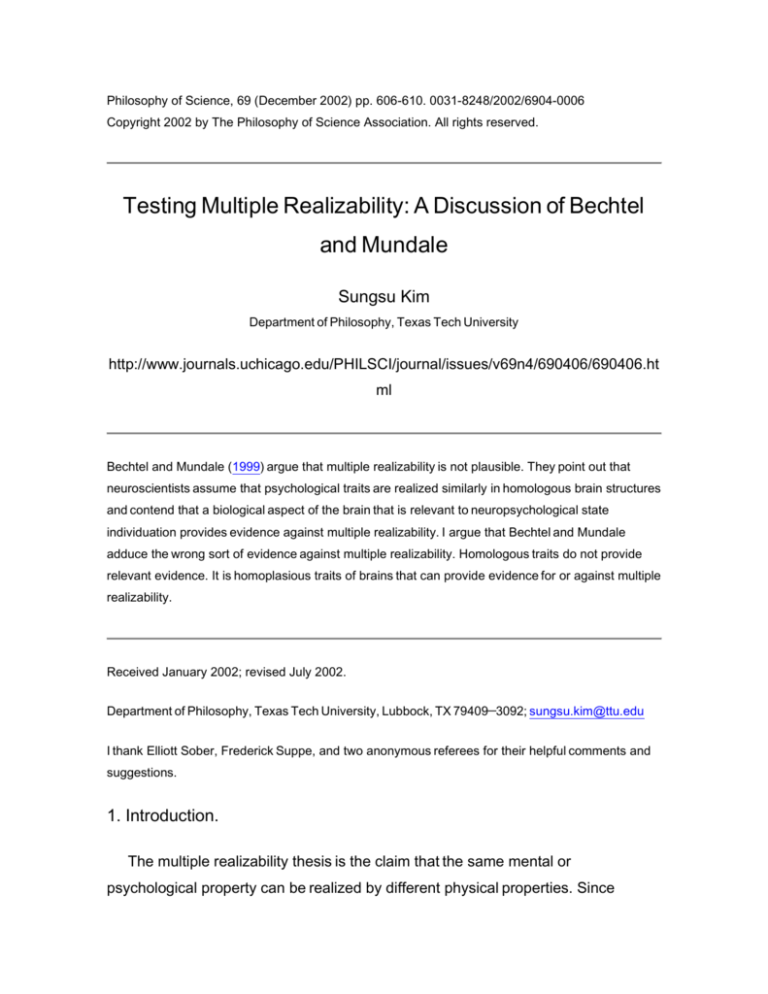
Philosophy of Science, 69 (December 2002) pp. 606-610. 0031-8248/2002/6904-0006
Copyright 2002 by The Philosophy of Science Association. All rights reserved.
Testing Multiple Realizability: A Discussion of Bechtel
and Mundale
Sungsu Kim
Department of Philosophy, Texas Tech University
http://www.journals.uchicago.edu/PHILSCI/journal/issues/v69n4/690406/690406.ht
ml
Bechtel and Mundale (1999) argue that multiple realizability is not plausible. They point out that
neuroscientists assume that psychological traits are realized similarly in homologous brain structures
and contend that a biological aspect of the brain that is relevant to neuropsychological state
individuation provides evidence against multiple realizability. I argue that Bechtel and Mundale
adduce the wrong sort of evidence against multiple realizability. Homologous traits do not provide
relevant evidence. It is homoplasious traits of brains that can provide evidence for or against multiple
realizability.
Received January 2002; revised July 2002.
Department of Philosophy, Texas Tech University, Lubbock, TX 79409 3092; sungsu.kim@ttu.edu
I thank Elliott Sober, Frederick Suppe, and two anonymous referees for their helpful comments and
suggestions.
1. Introduction.
The multiple realizability thesis is the claim that the same mental or
psychological property can be realized by different physical properties. Since
Putnam (1967) and Fodor (1975) proposed the multiple realizability thesis and
argued for the irreducibility of psychological properties based upon this thesis,
subsequent debates surrounding multiple realizability have often concerned
whether this alleged implication holds true.1
Philosophers however, have not paid much attention to the epistemological
issue of whether there is any evidence for the multiple realizability thesis. The thesis
is implied by a functionalist conception of the psychological the idea that a
psychological property is construed in terms of its causal roles abstracted from
physical properties and the main reason epistemological issues are neglected is
that lots of philosophers think that the multiple realizability thesis is a priori true.2
In their paper "Multiple Realizability Revisited: Linking Cognitive and Neural
States" (in this journal), Bechtel and Mundale discuss an important but less
frequently addressed issue: Is there any evidence for or against the multiple
realizability thesis? Bechtel and Mundale argue that a careful investigation of
neuroscientific practices provides us a reason to doubt the multiple realizability
thesis. Multiple realizability is not plausible, they contend, since a biological aspect
of the brain that is relevant to neuropsychological state individuation provides
evidence against multiple realizability. I argue that Bechtel and Mundale's argument
against multiple realizability is flawed, but claim that it invites an interesting
possibility for testing multiple realizability. I suggest a way in which neuroscientific
findings could have evidential impact on multiple realizability.
2. Testing Multiple Realizability: Homology or Homoplasy?
A frequently cited example in philosophical discussions of the multiple
realizability thesis is that the same mental property, say pain, (probably) has
different physical realizations in mammals, reptiles, and mollusca; another is that
the same mental property is subserved by different physical properties even within
a single species or individual. In discussing the identity thesis that mental states are
physical states of the brain, Putnam says,
Even though octopus and mammal are examples of parallel (rather than
sequential) evolution, for example, virtually identical structures (physically
speaking) have evolved in the eye of the octopus and in the eye of the
mammal, notwithstanding the fact that this organ has evolved from different
kinds of cells in the two cases. Thus it is at least possible that parallel
evolution, all over the universe, might always lead to one and the same
physical "correlate" of pain. But this is certainly an ambitious hypothesis
(Putnam 1967, 44).
The multiple realizability thesis does not imply that terrestrial life forms must have different
physical realizations of a mental property if they instantiate the same mental property.
However, the negation of the multiple realizability thesis, the identity thesis, implies that no
terrestrial organism can have different physical realizations of one and the same mental
property.3 If both octopus and mammal have pain but with different physical realizations
and if the same mental property is subserved by different physical properties even within a
single species or individual, shouldn't we conclude that the multiple realizability thesis is
confirmed and the identity thesis is rejected?
Bechtel and Mundale (1999) claim that these alleged biological examples, even
if they were right, should not be taken as evidence for multiple realizability. The
reason, according to them, is that the relevant criteria for individuation of brain
states as practiced in neurobiological and cognitive neuroscientific research are not
"physical" as intended in these examples. The individuation of brains in terms of
physical-chemical properties is an artificially "fine-grained" philosopher's invention
which does not find its place in actual neuroscientific practice.4 Bechtel and
Mundale point out that when neuroscientists individuate brain states, both
reference to psychological functions or processes and comparisons across species
are made. Bechtel and Mundale say,
One might think, at first glance, the ability to make comparison across
species actually depends upon multiple realizability. In fact, it is the very
similarity (or more precisely, homology) of brain structures which permits us
to generalize across certain species... . in the context of neuroscientific
research, they are not multiply realized. (Bechtel and Mundale 1999, 177
178, italics added).
Neuroscientists assume that multiple realizability is false in their practice and find that
psychological traits are realized similarly in homologous brain structures. I take it that
Bechtel and Mundale, at least implicitly, claim that once the relevant criteria for brain state
individuation based upon this homologous similarity are properly identified, we will have
reason to believe that the multiple realizability thesis is false.
Homologies are (physiological, morphological, behavioral, psychological, etc.)
characters shared between species that are inherited from their common ancestor.
On the other hand, a character shared between species is a homoplasy if it is not
inherited from a common ancestor, but arises from distinct origins. For instance,
bird wings and human arms are homologous with each other. Both evolved from the
forelimb of a common ancestor who lived around 300 million year ago. In contrast,
although bird wings and bat wings resemble each other, they evolved separately
and so their wings are homoplasious. The claim that some characters shared
between birds and bats are homoplasious does not imply that all characters are.
It is worthy noticing that testing multiple realizability requires at least two
independent lines of evidence. Suppose that a psychological property is realized
both in a terrestrial organism and in an alien organism. If the psychological property
has the same physical realization in these organisms, then these organisms provide
evidence against multiple realizability. If each has a different physical realization,
then they provide evidence for multiple realizability. In contrast, if the psychological
property is realized by the same physical property in two individual organisms of the
same species, this fails to provide relevant evidence for or against multiple
realizability.5 Regardless of the truth of the multiple realizability thesis, different
species will tend to exhibit the same character if it is an inherited character that was
present in their common ancestor.6 When the similarities are homologies, one can't
rule out the hypothesis that the species are similar simply because they share a
common ancestor and there is no need to invoke the hypothesis that there is only
one possible realization in this instance. It provides neither evidence for nor
evidence against the multiple realizability thesis that brain structures are
homologous.
Just as the wings of birds and bats are constructed from different materials and
supported by different limb digits, some psychological functions or processes might
be "constructed" from different "material" and supported by different structures. The
wings of birds and bats are homoplasious since they evolved separately. If brains
had evolved several times in different lineages and still had the same physical-cumstructural properties, then we would have evidence against the multiple realizability
thesis. For it is not likely (although not impossible) that brains with separate origins
would share the same structural properties if they could be multiply realized. On the
other hand, if structural properties corresponding to psychological properties cannot
be multiply realized, then brains must share the same structural properties even if
they are homoplasious. If brains arose repeatedly by convergence, this would
provide evidence against multiple realizability. It might be weak evidence since all
present and past terrestrial organisms are carbon-based, DNA-based, etc. and
biological conditions on Earth might make the brain the only realization that is
available. Nevertheless convergence would provide evidence. It is homoplasies,
not homologies, that can provide evidence for or evidence against multiple
realizability.
3. Conclusion.
I agree with Bechtel and Mundale that the way neuroscientists individuate brain
states casts doubt on the belief that the multiple realizability thesis is a priori true.
This invites us to consider an important question that has been neglected by
philosophers: the testability of multiple realizability. I argue, contrary to Bechtel and
Mundale's suggestion, that the fact that no psychological properties are multiply
realized in brains is neither surprising nor relevant to testing multiple realizability if
one is looking at homologous traits of brains. In order to test multiple realizability of
psychological properties in terrestrial organisms, we should look at homoplasious
traits of brains. The multiple realizability thesis is not a priori true. Homoplasious
traits of brains can provide evidence for or evidence against multiple realizability.
References
Batterman, Robert (2000), "Multiple Realizability and Universality", British
Journal for the Philosophy of Science 51: 115 145. First citation in article
Bechtel, William, and Jennifer Mundale (1999), "Multiple Realizability Revisited:
Linking Cognitive and Neural States", Philosophy of Science 66: 175 207. First
citation in article
Bickle, John (1998), Psychological Reduction: The New Wave. Cambridge, MA:
MIT Press. First citation in article
Enç, Berent (1983), "In Defense of the Identity Theory", The Journal of Philosophy
80: 279 298.
Fodor, Jerry (1975), The Language of Thought. Cambridge, MA: Harvard
University Press. First citation in article
Fodor, Jerry (1997), "Special Sciences Still Autonomous After All These Years",
in J. Tomberlin (ed.), Philosophical Perspectives 11: Mind, Causation, and World.
Malden, MA: Blackwell Publishers, 149 163. First citation in article
Hatfield, Gary (2000), "The Brain's "New" Science: Psychology, Neurophysiology,
and Constraint", Philosophy of Science 67 (Proceedings): S388 403. First citation
in article
Kim, Jaegwon (1998), Mind in a Physical World. Cambridge, MA: MIT Press. First
citation in article
Orzack, Steven, and Elliott Sober (1994), "Optimality Models and the Test of
Adaptationism", American Naturalist 143: 361 380. Reprinted in Steven Orzack
and Elliott Sober (eds.), Adaptationism and Optimality. New York: Cambridge
University Press, 45 63. First citation in article
Putnam, Hilary (1967), "Psychological Predicate", in W. Capitan and D. Merrill
(eds.), Art, Mind, and Religion. Pittsburgh: University of Pittsburgh Press, 37 48.
First citation in article
Shapiro, Lawrence (2000), "Multiple Realizations", The Journal of Philosophy 97:
635 654. First citation in article
Sober, Elliott (1988), Reconstructing the Past. Cambridge, MA: MIT Press.
Sober, Elliott (1999), "The Multiple Realizability Argument Against Reduction",
Philosophy of Science 66: 542 564. First citation in article
Sober, Elliott (2000), "Evolution and the Problem of Other Minds", The Journal of
Philosophy 97: 365 386.
1
See Bickle (1998), Fodor (1997), Shapiro (2000), and Sober (1999).
2
Psychological theories provide background theories against which neuroscientific theories are
tested (Hatfield 2000) and vice versa. There is no reason to believe that this practice is inconsistent
with the multiple realizability thesis nor does it show that the physical is epistemologically irrelevant
to the psychological if the psychological is multiply realizable.
3
See Kim (1998) for a species-specific identity thesis.
4
Shapiro (2000) makes a distinction between trivial multiple realizability and substantive multiple
realizability. The fact that a pendulum can be made of different materials and painted different colors
is multiple realizability only in a trivial sense (this pendulum example is discussed in Batterman
(2000)). Surely the multiple realizability thesis says more than this.
5
In the opening passage of their paper, Orzack and Sober (1994) describe Wittgenstein's joke
about "a man who is unconvinced by a claim he reads in a newspaper, so he buys another copy of
the same newspaper to double-check." They continue, "The point of the joke is that "it isn't just the
quantity of evidence in support of a claim that matters, but the quantity of independent evidence
(Sober 1999)" (361, italics and reference in original).
6
The fact that a certain trait is homologous does not settle the question of whether it is present
because of inheritance from a common ancestor
Orzack and Sober (1994) call this "phylogenetic
inertia"
or whether natural selection caused the trait to be retained once it originated, or both. See
Orzack and Sober (1994) for a detailed discussion.










